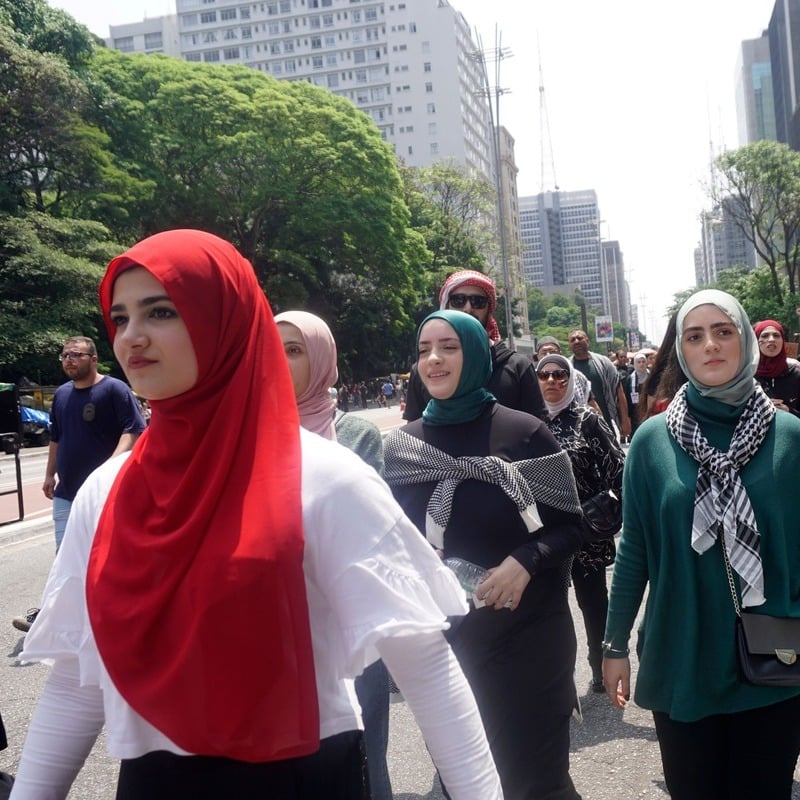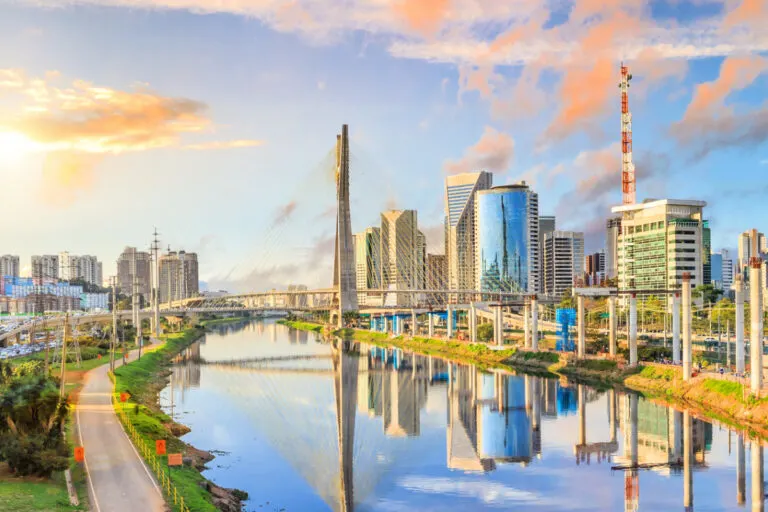It’s no secret South America is one of the best continents to be a digital nomad right now.
Having worked remotely from over 50 countries, including in Europe, North Africa, and as far away as Asia, nowhere did I find the same hospitality, friendliness to foreigners, and affordable cost of living as in the nether part of the Americas.
It’s almost an impossible challenge to narrow down my top digital nomad destinations in South America, as each city has its own particular charm, as well as pros and cons, but somehow, I have always felt a stronger pull to this world-famous yet strangely unsung major metropolis.
In fact, it might as well be one of my all-time favorites to be a remote worker:
Have We Been Underestimating Sao Paulo All Along?
Brazil may be a country best known for its paradisaical Atlantic beaches, slow-paced living, and tropical atmosphere, but an important piece of information most visitors tend to forget is that it is a continent-sized behemoth with a cultural diversity like no other.

A majority of the nomads I have come across basing themselves in Brazil were restricting their movements to Rio and surrounding towns on the carioca coastline, and I simply couldn’t fathom why the much larger, and arguably much more exciting Sao Paulo wasn’t a customary go-to pick.
Sao Paulo is the largest city in Brazil, home to over 20 million residents in its wider metropolitan area. On an extent, it is the largest urban conurbation in all of the Americas, both North and South, trumping New York and even almighty Mexico City.
It’s always been more popularly known as a financial hub. Its clusters of tall skyscrapers, modern districts and their swarm of men in suits, and hectic traffic have often posed impediments for culture-loving, crowd-wary nomads to consider it as a temporary base.
@nospaceinmypassport Have you been to Sao Paulo?😍 #brazil #saopaulo #visitbrazil #thingstodoinsaopaulo #saopaulocity #brazil🇧🇷 #brazilian #travelguides #traveltips
If you are willing to listen, in this article, I will tell you why reducing Sao Paulo to its business aspects a gross mistake; as someone who has worked remotely from this megalopolis for a number of weeks and ended up falling in love with it:
The Most Multicultural City In Brazil
For a city of this size, it shouldn’t be a surprise that Sao Paulo is a melting pot of cultures.
Still, many newcomers – like me – find themselves picking their jaws off the floor when going on an introductory walk around the busy city center.

Brazilians are often portrayed in the media as Latin-looking – whatever that means – tanned and overly sensual individuals, but there is no better place to shatter that stereotype and see what Brazil truly is about than its largest conurbation.
Much like the United States, Brazil is made up of several different migrant groups and ethnicities, who settled in the territory as far back as the Portuguese Empire and as late as the mid-20th century. Sao Paulo is a prime example of the influx of migration:
It is the textbook definition of a multicultural city, with each major district being comprised of an ethnic majority.

In Mooca, most of the residents are Italian descendants, owing to the Italian diaspora of the 40s and 50s that reached Brazil in hopes of establishing a better life for themselves.
There is no shortage of Mediterranean-style pizzerias, family-owned eateries, and the odd Italian flag proudly flying on front porches.
In Liberdade, however, you will find the largest Japanese community outside Japan.
Yes, they are based in Sao Paulo, Brazil, and they number as many as 20% of the city’s demographic.

Liberdade is famous for its Japanese-style winding streets, lined by ethnic shops and restaurants, ornate Japanese torii gate guarding the entrance to the lively neighborhood, and other Asian-influenced architecture.
Bras, on the other hand, has a thriving Arab community, with most of the residents descending from Syrian and Lebanese migrants to South America in the 20th century, and is jam-packed with Middle Eastern-inspired craft and food markets.
Wandering further afield, visitors will also come upon Jew, Lithuanian, Polish, Portuguese, and Afro-Brazilian communities.

In a way, Sao Paulo is Brazilian society in a nutshell, in all its plurality and wide range of colors, and it’s one of the reasons why I find it intrinsically fascinating.
Sao Paulo Is An Affordable Metropolis To Live
Sao Paulo may not be the easiest city to get around, particularly on foot, as it is a sprawling, vast state capital, but it has Brazil’s largest underground system, serving most of the historic center and adjacent bairros, and suburban trains that reach as far as the outskirts and smaller surrounding cities.
It may feel overwhelming at first – I won’t lie, I got lost once or twice riding the expansive metro – but I would soon learn that Uber prices, or private transportation in general are not as revoltingly expensive as they are in London or Paris.

Traveling is a lot easier with mobility apps, and while I value public transportation and 100% prefer using the metro myself when exploring a new city – it’s one of the best ways to observe life unfold and evaluate the infrastructure – Sao Paulo is one of those places where it’s best to Uber around.
While rates can vary drastically between different pickup points and destinations, I would say I was spending, on average, between US$10 to US$15 per ride commuting from my Paulista Avenue, adults-only Soul Hostel to other major points of interest.
These hardly ever broke the bank.

What Has Sao Paulo Got To Offer To Digital Nomads In Particular?
When it comes to digital nomad infrastructure, Sao Paulo is probably one of the best-equipped cities in South America.
It boasts a high concentration of coworking spots, with some of my favorites including Osmose Coworking for the comfort and privacy offered, BUCC, for the shared common spaces used by startups and entrepreneurs that foster interaction and exchange, and Vila Madalena’s hippie Estacao Coworking.
Strangely enough, you will find cafe culture is not as pronounced in Brazil in general as it may be elsewhere.

The concept of a chill environment where you have workstations, and you can order food and drinks on the side is not widely disseminated.
There’s the odd cafe or two, and certainly there are plenty of Starbucks outposts to pick from, but Brazilians have a professed love for padarias, self-service, buffet-style bakeries, and food courts, especially in big shopping complexes.
When it comes to culture, however, you should also not underestimate Sao Paulo.
An Unsung Cultural Hotspot
@anayatravel
Granted, it does not have a perfectly well-preserved colonial core like Bogota, in Colombia, or the Ecuadorian capital Quito, and its sea of skyscrapers infamously block the view of flamboyant churches and 19th-century mansions, but these historical gems are still there if you know where to look.
One of the most beautiful traditional structures is Patio do Colegio, in the Historic Center, built on the exact site where Sao Paulo was founded by Portuguese missionaries in 1554.
The Cathedral Square is not to be missed, either, with its majestic Se serving as a clear reminder of Brazil’s Luso (Portuguese) origins.

Experiencing the paulista social scene is also an inherent part of Sao Paulo’s cultural offer, with artsy districts like Vila Madalena and Pinheiros coming to life in the nighttime, particularly at weekends, when youngsters spill onto the alleys and flock into the quirky street-corner bars.
Additionally, Sao Paulo has a plethora of green oases and protected parks where residents and visitors alike can escape the hustle and bustle.
The best-frequented and safest places to hang around are Ibirapuera Park, Villa Lobos Park, Independence Park, and Burle Marx Park.
How Much Do Nomads Spend On Average In Sao Paulo?

According to NomadList, the cost of living for locals is an acceptable US$672 per month, but it rises up to US$1,267 for foreign residents.
It is important to note, however, that foreigners earning in dollars, euros, or other strong currencies are prone to spending more due to their overvalued money, compared to the Brazilian Real, but this does not necessarily mean that living costs for digital nomads will be as high as that.
It all depends, of course, on the location of your Airbnb or long-term rental, whether you eat out at expensive restaurants every day, how often you take Uber every day, and your traveling style.

NomadList lists fast internet, ‘lots of fun stuff to do’, and the warm weather as further ‘pros’ that make Sao Paulo a great digital nomad destination.
On The Downside, Sao Paulo Is Not As Safe
On the downside – and this I can corroborate with – it is not as safe as, say, Argentina’s Buenos Aires or Chile’s Santiago.
Urban violence and pickpocketing are rampant, and nomads, especially Americans who are not conversational in Portuguese, must keep a high level of situational awareness at all times when walking the streets to avoid unfortunate encounters.

In this case, regular safety advice applies, such as not carrying unnecessary valuables, not using your phone out in the open in public, and keeping a watchful eye on personal belongings if using public transportation.
With that being said, I was never a victim of violence nor robbed in Sao Paulo during my non-consecutive three weeks of being a nomad there, and I would warmly recommend it to everyone in the community who’s craving for a city break that’s a little more edgy, cool, and with endless possibilities.
Credit: Source link

